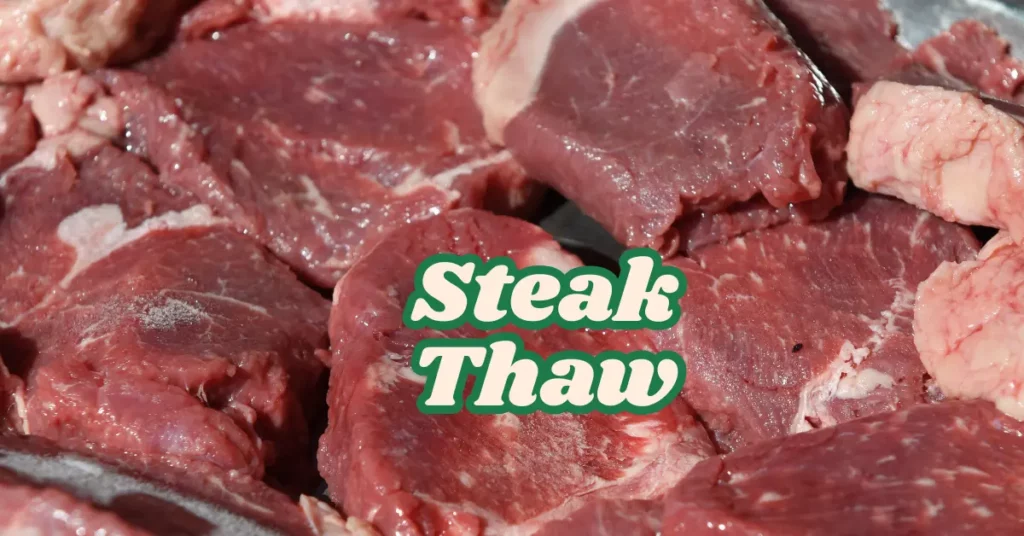This post may contain affiliate links. If you use these links to buy something we may earn a small commission. Thanks.
When you’re planning a steak dinner, timing is everything. From the seasoning to the sear, every detail matters. But there’s one step that’s often overlooked thawing the steak properly. Rushing this process or using the wrong method can impact both the flavor and safety of your meal. So, how long should you let a steak thaw? That depends on several factors, including the cut of meat, the thawing method, and your available time.
This guide will walk you through everything you need to know about thawing steak the right way safely, efficiently, and without compromising on quality.
Factors That Affect Thawing Time
Before diving into the specific thawing methods, it’s important to understand what influences how quickly or slowly your steak will thaw:
1. Thickness and Cut of the Steak
A thick-cut ribeye will take significantly longer to thaw than a thin flank or skirt steak. As a rule of thumb, the thicker the steak, the more time it needs to thaw completely.
2. Initial Freezing Temperature
Meat frozen at ultra-low temperatures (like in deep freezers) will take longer to thaw than meat stored in a standard freezer at 0°F (-18°C).
3. Packaging Type
Vacuum-sealed steaks thaw faster and more evenly than those wrapped in heavy plastic or butcher paper. A tightly sealed steak also reduces the risk of contamination during the thawing process.
4. Environment Temperature
Whether you’re thawing in the refrigerator, on the counter (not recommended), or in cold water, ambient temperatures make a big difference in thawing time.

Refrigerator Thawing: The Safest Method
If you want to preserve the texture, taste, and safety of your steak, thawing in the refrigerator is your best bet. It’s a slow process, but the results are worth it.
How Long Does It Take?
On average, a 1-inch thick steak takes about 12 to 24 hours to thaw in the refrigerator. Thicker cuts may require up to 36 hours.
Best Practices:
- Place the steak on a plate or in a shallow dish to catch any juices.
- Keep it on the bottom shelf to avoid cross-contamination.
- Keep the refrigerator temperature at or below 40°F (4°C).
How Long Can Steak Stay in the Fridge After Thawing?
Once thawed, steak can be safely kept in the refrigerator for 3 to 5 days before cooking. This makes refrigerator thawing a flexible option if your dinner plans shift.
Pros:
- Safest method
- Maintains quality
- Minimal risk of bacterial growth
Cons:
- Time-consuming
- Requires advance planning
Cold Water Thawing: The Faster Alternative
Need to thaw steak in a pinch? Cold water thawing is a reliable method that’s faster than the refrigerator but still food-safe when done correctly.
How Long Does It Take?
Cold water thawing takes about 1 to 2 hours, depending on the thickness of the steak.
Step-by-Step Instructions:
- Keep the steak sealed in a leak-proof plastic bag.
- Fill a bowl or sink with cold tap water—not warm or hot.
- Submerge the sealed steak in the water.
- Change the water every 30 minutes to maintain a consistent temperature.
Important Safety Note:
Never use warm or hot water, as it can bring the outer layer of the steak into the “danger zone” (40°F–140°F), where bacteria can multiply rapidly.
Pros:
- Much faster than refrigerator thawing
- Still relatively safe
- Great for same-day cooking
Cons:
- Requires monitoring
- Must cook steak immediately after thawing
Microwave Thawing: The Quickest Option (But Risky)
If you’re really pressed for time, you might consider using your microwave’s defrost function. However, this method can compromise the steak’s texture and even start cooking parts of it.
How Long Does It Take?
Typically, 5 to 10 minutes, depending on your microwave’s wattage and the size of the steak.
Microwave Thawing Tips:
- Use the defrost setting and rotate the steak frequently.
- Monitor closely to avoid cooking the edges.
- Cook the steak immediately after thawing never refrigerate or refreeze it.
Pros:
- Fastest method available
- Convenient for emergency situations
Cons:
- Risk of uneven thawing
- Can partially cook the steak
- May result in a rubbery texture
Can You Cook Steak Without Thawing It First?
Interestingly, yes—you can cook a steak straight from the freezer. It takes longer, but cooking frozen steak can still yield a delicious result, especially with the right technique.
How Much Longer Does It Take?
Cooking a frozen steak usually takes about 50% longer than a thawed one.
Best Methods for Cooking Frozen Steak:
- Reverse Sear: Start cooking at a low oven temperature and finish with a hot sear.
- Sous Vide: A great method for precise internal temperatures before searing.
- Grilling: Start on indirect heat and finish over direct flame.
When It Makes Sense:
- When you forgot to thaw and need a quick solution
- To preserve moisture and reduce overcooking
How to Tell If Your Steak Is Fully Thawed
So how do you know when your steak is ready to cook?
Signs of Proper Thawing:
- No hard or icy spots in the center
- Soft and pliable throughout
- Even coloring with no grayish areas
- Still cold to the touch but not frozen solid
If the center is still stiff or icy, give it more time to thaw, especially for thick cuts like T-bones or bone-in ribeyes.
Common Mistakes to Avoid When Thawing Steak
Even experienced cooks can make these mistakes when trying to thaw meat:
1. Leaving Steak on the Counter Too Long
Room temperature thawing is unsafe and not recommended. Bacteria grow rapidly between 40°F and 140°F, making this a food safety hazard.
2. Using Hot Water
Although tempting, hot water can lead to uneven thawing and outer-layer bacterial growth.
3. Thawing Without Proper Wrapping
Leaving meat exposed in the fridge can cause it to dry out or pick up odors from other foods.
4. Refreezing Steak Improperly
If you thaw steak using the cold water or microwave method, do not refreeze unless it’s been cooked first. Refreezing raw meat after quick-thawing methods increases the risk of spoilage and texture loss.
Final Tips for Best Results
- Plan ahead. Always aim to thaw your steak in the refrigerator when possible.
- Use cold water only when needed, and follow food safety guidelines closely.
- Always cook steak immediately after quick-thawing via microwave or water methods.
- Label your meat with the freeze date for better kitchen organization and planning.
- Avoid shortcuts that compromise safety or flavor good steak deserves better.
Conclusion
Thawing steak the right way is just as important as how you cook it. Whether you prefer a ribeye, New York strip, or filet mignon, taking the time to thaw it properly ensures a better texture, more even cooking, and a safer dining experience.
To recap:
- Refrigerator thawing takes 12–24 hours and is the safest.
- Cold water thawing takes 1–2 hours and is good for same-day meals.
- Microwave thawing takes 5–10 minutes but should be used sparingly.
- You can cook steak from frozen—just adjust your technique and timing.
Choose the method that best fits your schedule, and you’ll be one step closer to serving the perfect steak.
